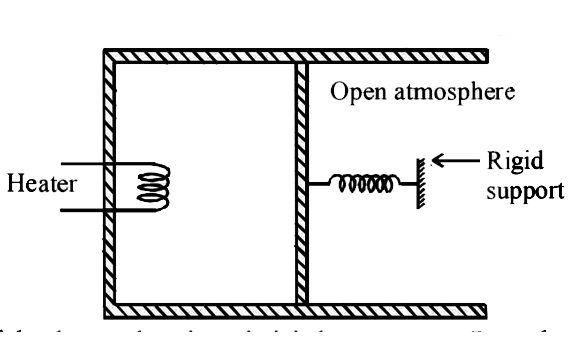In A double -acting steam engine, the avearge pressure of steam is 8×104Nm−2. The length of the stroke is 0.8 m and area of cross-section of the piston is 0.18m2. If the piston makes 6 revolution per second, calculate the horse power of the engine.
Step by step video & image solution for In A double -acting steam engine, the avearge pressure of steam is 8xx10^(4) Nm^(-2). The length of the stroke is 0.8 m and area of cross-section of the piston is 0.18 m^(2). If the piston makes 6 revolution per second, calculate the horse power of the engine. by Physics experts to help you in doubts & scoring excellent marks in Class 11 exams.
Topper's Solved these Questions
- BOOK - SL ARORACHAPTER - THERMODYNAMICSEXERCISE - Problems from competitive examinations22videos
THERMODYNAMICS
- BOOK - SL ARORACHAPTER - THERMODYNAMICSEXERCISE - Problems for self practice97videos
THERMODYNAMICS
- BOOK - SL ARORACHAPTER - Thermal Properties of MatterEXERCISE - Exercise449videos
Thermal Properties of Matter
- BOOK - SL ARORACHAPTER - Units and MeasurementsEXERCISE - Exercise499videos
Units and Measurements
Similar Questions
In a reciprocating steam engine, the avearge pressure of steam is 50Nm−2. The length of half stroke is 50 cm and area of cross section of the piston is 400cm2. If the engine is making 300 strokes per minute, calculate power of the engine in k W.
View SolutionIn a double acting steam engine, the average pressure in 90Ncm−2, the area of the piston is 7.46cm2, the length of the strokes is 1 meter and the number of revolution per second is 5. find the horse power of the engine.
View Solution
Knowledge Check
- Question 1 - Select One
The area of cross section of a steel wire (Y=2.0×1011N/m2) is 0.1cm2. The force required to double is length will be
A2×1012NB2×1011NC2×1010ND2×106N - Question 2 - Select One
In a car lift , compressed air with a gauge pressure of 4.0×105 Pa is used to raise a piston with a circular cross-sectional area . If the radius of the piston is 0.17 m , what is the maximum mass that can be raised using this piston ?
A530 kgB3700 kgC9800 kgD22,000 kg
The cross-sectional area of water pipe entering the basement is 4cm−2 . The pressure at the point is 3.5×105Nm−2 and the speed of water is 2.2ms−1 . This pipe tapers to a cross-sectional area of 2cm2 when it reaches the second floor 10 m above . Calculate the speed and pressure at the second floor. use g=10m/s2.
View SolutionThe cross-sectional area of water pipe entering the basement is 4 x 10−4m2. The pressure at this point is 3 x 105Nm−2 and the speed of water is 2 ms−1. This pipe tapers to a cross-sectional area of 2 x 10−4m2 when it reaches the second floor 8 m above. Calculate the speed and pressure at the 2nd floor
View SolutionThe pressure of a gas contained in a cylinder with a movable piston is 300 Pa. The area of the piston is 0.5m2. Calculate the force that is exerted on the piston.
View SolutionA cylinder fitted with a spring loaded piston, shown in the figure, contains 0.01(m)3 gas at a pressure of 105Pa. The cross-sectional area of the piston is 0.05m2. Initially, the spring does not touch the piston but atmospheric pressure of 105Pa acts on the piston. The gas is slowly heated till the volume is increased to three times the original value. If the forcé constant of the spring is 25kNm, calculate the work done (in kJ ) by the gas.
'(##CEN_KSR_PHY_JEE_C15_E01_031_Q19##)'View SolutionA cylinderical vessel contaning liquid is closed by a smooth piston of mass m. the area of cross-section of the piston is A. if the atmospheric pressure is P0, Find the pressure of the liquid just below the piston.
View SolutionAn ideal monatomic gas is confined in a cylinder by a spring-loaded piston of cross-section 8.0×10−3m2. Initially the gas is at 300K and occupies a volume of 2.4×10−3m3 and the spring is in its relaxed (unstretched, unompressed) state, fig. The gas is heated by a small electric heater until the piston moves out slowly by 0.1m. Calculate the final temperature of the gas and the heat supplied (in joules) by the heater. The force constant of the spring is 8000N/m, atmospheric pressure is 1.0×105Nm−2. The cylinder and the piston are thermally insulated. The piston is massless and there is no friction between the piston and the cylinder. Neglect heat loss through lead wires of the heater. The heat capacity of the heater coil is negligible. Assume the spring to be massless.
 View Solution
View Solution

